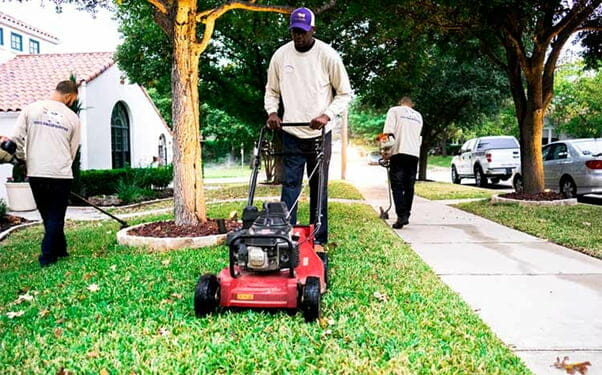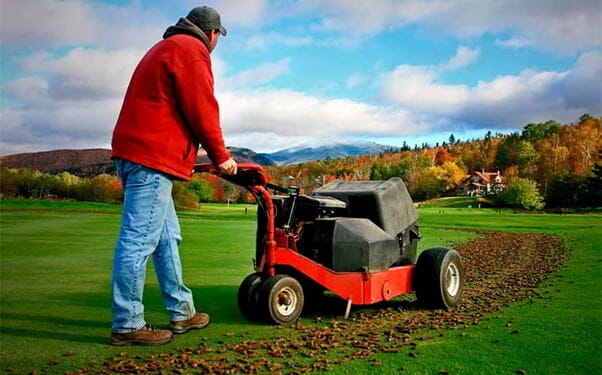Aeration and dethatching are crucial lawn care methods that effectively address soil compaction using distinct techniques, yielding comparable outcomes. This is because both procedures enable the soil to intake more oxygen, moisture, and essential nutrients.
You can dethatch and aerate at the same time if your lawn has a severe thatch and soil compaction problem. Spring dethatching and aeration also prepare your topsoil for overseeding
Performing both aeration and dethatching is encouraged when long-term thatch control is out of consideration. Aerating and dethatching your lawn works best when seeking a quick solution for your thatch and soil compaction problem.
Should I aerate or dethatch my lawn first?

Remove the excess thatch from your lawn before aerating to achieve the best results; dethatching your lawn before aerating is a strategy that works on even the most compacted grounds. The process involves removing the thick layers of interwoven organic debris and live microorganisms from the soil surface, allowing core aerators to effectively penetrate the soil, reaching the desired depth necessary for water and air to get to the root zone.
How often should you dethatch and aerate your lawn?
Aeration and dethatching can be performed annually, depending on your lawn grass type or soil composition. Other factors include your lawn foot traffic and local weather conditions.
Aeration
It’s necessary to aerate lawns with thick clay soil at least once yearly to maintain a healthy growing lawn. Aerate twice a year if the lawn gets a lot of foot traffic to avoid compacted lawn soil. Fall and spring seasons are good periods for aerating your lawns because the moist soil allows aerators to penetrate deep into the ground to aid the flow of air and water to the roots. Sandy or loamy soils have a loose structure that can become weakened if you aerate too often. It is best to aerate lawns with sandy or loamy soils every couple of years during springtime.
Dethatching
You can dethatch annually or when your lawn feels spongy or bouncy underfoot. Thatch becomes a problem when it exceeds 0.5 inches, and when it does, you may detach annually or biannually during spring and fall, depending on the severity. To measure your lawn thatch level, dig up a small section of your turf and soil with a hand trowel. Check the thatch thickness using a regular ruler, a healthy thatch should not be more than 0.5 inches, and if your lawn thatch exceeds that amount, it’s time to dethatch.

What do you do after aerating and dethatching your lawn?
Aerating and dethatching will leave your grass in terrible condition. Fertilizing and intensive watering are just a few of the lawn recovery treatments that’ll nurture and restore your grass quickly. Below is a list of essential steps that’ll help you have a great-looking lawn in no time.
Essential steps after aerating
- Allow the soil plugs to disintegrate on your lawn for a couple of weeks, then mow over them to hasten their reabsorption into the soil.
- Apply a slow-release fertilizer to your lawn as soon as the aeration process is complete.
- At this stage, your lawn is ready to receive new seeds. Reseed your freshly prepared lawn, overseed with fresh grass seedlings to “grow in” the bare and patchy areas of your yard.
- Put down a layer of mulch over the newly seeded lawn. Doing this protects the seedlings from being washed away and also provides them with additional nutrients during germination.
- Water your entire lawn repeatedly.
Essential steps after dethatching
- Evacuate the dead organic material removed by the dethatcher. Pile it up and recycle it back into your lawn as compost.
- Water your lawn continuously to encourage root growth and hasten the germination of new seedlings.
- Dethatching your lawn can cause your lawn grass to be stressed. Apply a thin layer of fertilizer over your topsoil to nurture your recovering lawn grass.
- Seed your lawn with quality grass seedlings to get that healthy, thick, beautiful lawn.
- Avoid walking on your lawn for three weeks to allow your sprouting seeds to establish themselves and help the lawn heal from the detaching process.
Is it better to dethatch in spring or fall?
Late spring through early fall is the active growing period for most grass types and hence, the best time to detach your lawn. Detach northern grasses in the fall or spring seasons. Fescue, bluegrass, and ryegrass do not generate much thatch, and they can be dethatched in the early fall. Dethatch lawns with Kentucky bluegrass during its active growing spring and fall seasons.
Southern grasses produce more thatch compared to northern grasses. They can be detached during their late spring and early summer peak growing periods to allow them to recover from any damage quickly. You can dethatch Bermuda and buffalo grass just before their summer active growing period. Depending on where you live, this should be late spring or early summer. Lawns with zoysia grass can be dethatched in the summer during its active growing period. Do not dethatch warm-season grass in the fall because it makes them vulnerable to frost and sub-zero temperatures during winter.
Dethatching equipment can inflict substantial damage on healthy grass when pulling thatch out of the lawn. Scheduling your lawn dethatching procedure to coincide with active grass growth periods will hasten your grass recovery and help to restore your lawn within the shortest possible time. Dethatching your turfgrass when it is dormant or stressed can kill your lawn.
Should you dethatch or aerate before overseeding?
Aeration or dethatching before overseeding your lawn are the best methods that assure excellent germination rates. Both methods provide good seed-to-soil contact, which is essential when overseeding a particularly leafy area. In this section, we will examine the two ways to determine which one is the best option.
Dethatching
Dethatching reveals more soil area to receive seedlings; a feat accomplished using a dethatcher to remove the thatch layers embedded on the soil surface. The dethatcher also mildly tills the soil with its metal tines that grab thatch and grass to pull them out, thereby turning-over significant amounts of earth in the process. The action implants seedlings in the ground instead of sprouting on the soil surface. Dethatching also helps you overseed successfully by pulling crabgrass and other weeds along with thatch during the procedure. This means that grass seeds have a higher chance of growing without being choked by weeds.
Core Aeration
Professional landscapers consider aeration to be the best foundation for overseeding. Aeration reduces soil compaction and removes thatch and weeds by creating small holes that improve the penetration of water and air deep into the soil. These are the exact conditions that promote seed germination and deep root growth. Lawn keepers must set their aerator to create more holes per square foot than usual to achieve a high germination rate. Leaving the soil plugs on your lawn instead of raking them into the holes gives you more soil exposure. Aeration provides better seed-to-soil contact because the holes created by core aerators provide ideal nests for seeds to access nutrients and establish roots deep in the lawn soil.
Should I fertilize after dethatching?
Fertilizing after dethatching is in order depending on your lawn and weather conditions. Dethatching can be brutal on turfgrass, and fertilizing your lawn is an essential part of your grass recovery journey. Applying fertilizer to a detached lawn should be a slow, deliberate process. Avoid cheap nitrogen fertilizers-products that contain herbicides, and use the real thing instead. To gently strengthen your grass, apply a pound of slow-release urea fertilizer per 1,000 square feet. You could also use the opportunity to drop-dress your lawn with refined manure or compost.
FAQ's
Does dethatching hurt your lawns?
Dethatching is an aggressive procedure that can hurt your lawn grass. Lawn dethatching is performed using a dethatcher, a mechanical device designed to remove thatch layers from the soil surface. However, the dethatcher can cause a lot of damage to the lawn because, during the dethatching process, the dethatcher can remove quite a significant amount of healthy lawn grass along with thatch resulting in a thinning or patched lawn.
How can I get rid of thatch naturally?
You can get rid of thatch naturally by adopting practices that do not involve the use of invasive lawn procedures such as dethatching or aerating.
They are:
- Grow cool-season grasses that produce minimal amounts of thatch. Examples are perennial ryegrass and tall fescue.
- Promoting the growth and spread of earthworms.
- Resist the tendency to frequently over-water your lawn. The key is to water deeply and infrequently.
- Avoid the urge to over-fertilize your lawn. Overuse of crude and cheap chemical fertilizers, particularly quick-release high nitrogen fertilizers, promotes the generation of thatch.
- Leave lawn clippings on the ground after mowing. It encourages the growth of microbial agents that break down thatch.
What type of grass produces more thatch?
Warm-season grass produces more thatch than any other grass type. Warm-season grass like Bermuda and zoysia generate more thatch than cool-season grasses like ryegrass and bluegrass. Also,cool-season grasses such as tall fescue and perennial ryegrass have bunch growth characteristics, and they hardly develop a thatch problem.
Can I detach during a drought or heatwave?
No, you can’t dethatch during a drought or heatwave. Droughts and heatwaves create stressful conditions for your turfgrass. Dethatching your lawn during periods of lawn stress will kill your grass, and your lawn will not recover. You’ll need at least 45 days of wet and moist conditions after dethatching for your grass to recover.






